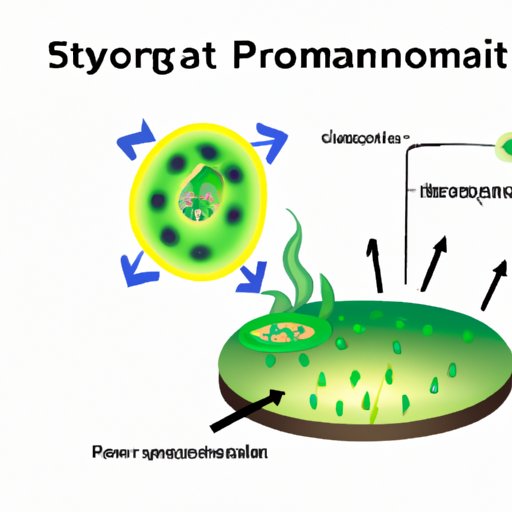I. Introduction
Plants are not just passive organisms that sit and wait for things to happen. Instead, they have evolved complex physiological systems that help them to survive in some of the harshest environments on Earth. One of the most important of these systems is the stomata, which take in carbon dioxide and release oxygen during photosynthesis. In this article, we will explore the structure, function, and evolution of stomata, as well as their regulation in response to environmental cues and pollutant exposure.
II. Explanation of Stomata and their Functions in Plants
Stomata are small pores that are present on the surface of leaves, stems, and other plant organs. They are surrounded by two specialized cells, known as guard cells, which can change shape to open or close the pore. When the stomata are open, they allow carbon dioxide to enter the plant and oxygen to exit. This process is essential for photosynthesis, which is the primary means by which plants obtain energy from sunlight.
The structure of stomata is relatively simple. The guard cells contain chloroplasts and are specialized for photosynthesis. The pore is bordered by a pair of cells that are much smaller than the surrounding cells, known as subsidiary cells. These cells play a critical role in regulating the function of the stomata by providing support and feedback to the guard cells. The position, arrangement, and shape of stomata can vary significantly between different plant species and even between tissues within the same plant.
III. Evolution of Stomata
The earliest land plants lacked stomata, but it is thought that they evolved around 400 million years ago. The appearance of stomata co-occurred with the development of vascular tissue, which allowed plants to grow taller and more complex. The evolution of stomata allowed plants to regulate their water content more effectively by controlling the rate of transpiration. Notably, the invasive nature and evolution of plant photosynthesis relied on the development of the stomata system.
Over time, stomata have become more specialized and complex, allowing plants to respond to changing environmental conditions. For example, some plants have developed stomata that can close in response to stresses like dry or high temperatures.
IV. Stomatal Regulation in Response to Environmental Cues
Stomatal regulation is essential for plant growth and survival. The opening and closing of stomata are regulated by the turgor pressure of the guard cells surrounding the pore. In response to internal and external cues, these cells can change shape and turgor pressure to open or close the stomata.
Light is the primary external cue that affects stomatal opening. Blue light induces stomatal opening and closing, and red light induces stomatal closing. This system helps to ensure that plants can regulate their water balance during the day when photosynthesis is active and conserve water when it is dark. CO2 is another external cue that affects stomatal closure. When CO2 concentrations are high, the stomata are turned off, which reduces water loss and increases the efficiency of photosynthesis. Drought, a major concern in agriculture, induces stomatal closure in order to reduce water loss.
V. Experiment-based Article that Explores the Relationship between Stomatal Density and Plant Growth
To study the relationship between stomatal density and plant growth, a group of researchers measured both the stomatal density of several plant species and their growth rates. The results showed that plants with higher stomatal density had higher growth rates. Further research is needed to determine the causality of the relationship, but it is thought that the higher the density, the higher the productivity and efficiency of photosynthesis, which fuels growth.
VI. Stomatal Dysfunction in Plants Exposed to Pollutants
Pollution, both in air and soil, can cause stomatal dysfunction in plants. For example, ozone can produce reactive oxygen species that turn off the stomata, causing plants to become stressed, which ultimately leads to the reduction of the productivity of plants. Nitrogen oxide reacts with water and produces nitric acid, which leads to a lower pH in the soil. High soil acidity prevents root cells from absorbing nutrients and causes stress in the plant, resulting in reduced stomatal function.
Through monitoring plants, toxins, and other environmental pollutants through their stomata, scientists are studying the health of the planet and the overall health of the Earth’s ecosphere. Understanding how toxins affect stomata helps scientists and conservationists to understand how plants indicate environmental stress and how humans can protect the planet’s life forms.
VII. Conclusion
Overall, stomata are essential structures that allow plants to maintain a healthy water balance while also enabling them to carry out photosynthesis. They have evolved over time to become more specialized and complex, allowing plants to respond to changing environmental conditions. The regulation of stomata is responsive to internal and external cues, allowing plants to conserve water and maximize the efficiency of photosynthesis under different conditions. With the availability of plant biotechnology tools and computational approaches, scientists can now study and understand the stomata at an individual level and also the collective population of stoma in specific plants. As we recognize the importance of plants and the environment, understanding the importance of stomata becomes even more critical and relevant towards plant management and conservation.
